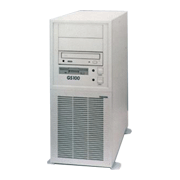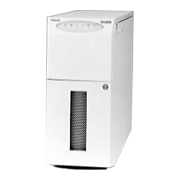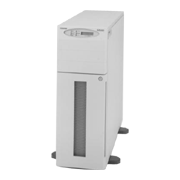Toshiba announced the GS series of PC servers in 1996. The series consisted of mid-range models — the GS500 announced in February 1996, the GS700 in October 1996, and the GS700S, the GS750S, and the GS700FR in October 1997; entry-level models — the GS400 announced in October 1996, the GS200D in May 1997, and the GS200S and the GS300S in October 1997; and compact entry-level models — the GS100 announced in July 1996 and the GS200 and the GS250 in October 1996.
Toshiba concentrated on scalability and high reliability for the GS series, which it expected would be used for mission-critical system applications. To provide scalability, the GS servers were implemented with symmetric multiprocessing with one to four CPUs. For increased reliability, the GS servers featured power-supply redundancy, RAID disks, server monitoring features, and cluster configurations with failover functionality. The GS700FR was supplied with Super Fault Resilient (SFR) technology, a technique to avoid system crashes. (See the GS700FR page for details on the SFR function.)
Having redundant power-supply units meant the servers could avoid interrupting system operations when a power-supply unit failed, but also allowing hot swapping of power-supply units meant faulty units could be replaced without interrupting system operations.
The initial models were supplied with RAID 0, RAID 1, and RAID 5 disks, and RAID 10 and RAID 50 support was added after May 1997. Online disk expansion functionality was also incorporated so that hard-drive capacity could be increased without interrupting system operations. And the hot-spare disk and hot-swappable disk functions made it easier to service and repair the server when a hard drive malfunctioned.
The servers were furnished with an AMS board for server monitoring that operated independently of the server’s CPUs. As a result, regardless of the server’s CPU state, it was always possible to monitor and control the server’s hardware either locally or remotely via a LAN connection.
The first models supported tightly coupled clusters of two computers sharing hard drives. With the introduction of DNCWARE for HA in October 1997, models began supporting four-node tightly coupled clusters.
| GS100 | GS200 | GS250 | |
|---|---|---|---|
| Introduced | July 1996 | October 1996 | October 1996 |
| CPU | 133 MHz Pentium x 2 | 200 MHz Pentium Pro | 200 MHz Pentium Pro |
| Max. memory | 256MB | 256MB | 256MB |
| Max. disk capacity | 2GBX6 | 2GBX6 | 4GBX6 |
| Fault tolerance features | Redundant power supply; HDD RAID0/1/5(*1) |
Redundant power supply; HDD RAID0/1/5(*1) |
|
| Other details | NetWARE4.1J | NetWARE |
| GS200D | GS200S | GS300S | GS400 | |
|---|---|---|---|---|
| Introduced | May 1997 | October 1997 | October 1997 | October 1996 |
| CPU | 200 MHz Pentium Pro x 2 | 233/300 MHz Pentium II x 2 | 300 MHz Pentium II x 2 | 200 MHz Pentium Pro x 2 |
| Max. memory | 512MB | 512MB | 512MB | 512MB |
| Max. disk capacity | 4GB×6 | 9GB×4 | 4GB×6 | 4GB×6 |
| Fault tolerance features | Redundant power supply; RAID 0, 1, 5, 10, 50 HDD;/ Online HDD expansion |
Redundant power supply; Redundant cooling fans; RAID 0, 1, 5, 10, 50 HDD; Online HDD expansion |
Redundant power supply; RAID 0, 1, 5, 10, 50 HDD;/ Online HDD expansion |
Redundant power supply; RAID 0, 1, 5 HDD(*1) |
| Other details | Automatic shutdown; Two-node tightly coupled clusters; Server monitoring (AMS) |
Automatic shutdown; Server monitoring; DNCWARE for four-node clusters |
Automatic shutdown; Server monitoring; DNCWARE for four-node clusters |
Automatic shutdown; Two-node tightly coupled clusters; Server monitoring(*2) |
| GS500 | GS700 | GS700S | GS750S | GS700FR | |
|---|---|---|---|---|---|
| Introduced | February 1996 | October 1996 | October 1997 | October 1997 | October 1997 |
| CPU | 133 MHz Pentium x 4 | 200 MHz Pentium Pro x 4 | 200 MHz Pentium Pro x 4 | 200 MHz Pentium Pro x 4 | 200 MHz Pentium Pro x 4 |
| Max. memory | 1 GB | 4 GB | 4 GB | 2 GB | |
| Max. disk capacity | 4 GB x 18 | 4 GB x 18 | 9 GB x 18 | 9 GB x 18 | 4 GB x 18 |
| Fault tolerance features | Redundant power supply; RAID 0, 1, 5 HDD |
Redundant power supply; RAID 0, 1, 5 HDD(*1) |
Redundant power supply; RAID 0, 1, 5, 10, 50 HDD; Online HDD expansion |
Redundant power supply; RAID 0, 1, 5, 10, 50 HDD; Online HDD expansion |
Redundant power supply; RAID 0, 1, 5, 10, 50 HDD; Online HDD expansion; SRF(*3) |
| Other details | Automatic shutdown; Two-node tightly coupled cluster configuration; Server monitoring(*2) |
Automatic shutdown; Server monitoring; DNCWARE for four-node clusters |
Automatic shutdown; Server monitoring; DNCWARE for four-node clusters |
Automatic shutdown; Server monitoring; DNCWARE for four-node clusters |
(*2)Added from May 1997 on.
(*3)SFR: Super Fault Resilient. A function that avoids server crashes when a fault occurs by automatically returning to the state just prior to where a fault occurred and resuming execution.




